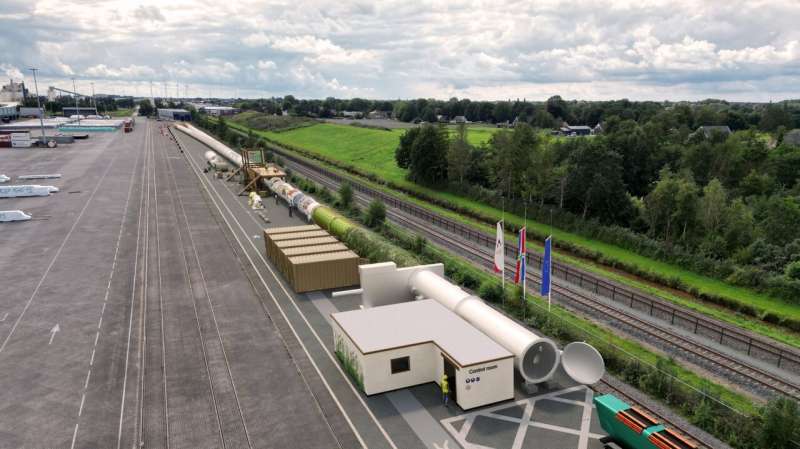This article has been reviewed according to Science X's editorial process and policies. Editors have highlighted the following attributes while ensuring the content's credibility:
fact-checked
reputable news agency
proofread
Transport of the future? Europe's longest hyperloop center opens

Europe's longest tunnel for testing hyperloop technology opens Wednesday in the Netherlands, with operators hoping passengers could one day be whisked from Amsterdam to Barcelona in a couple of hours.
On a disused railway center near Veendam in the north of the country sits a sleek Y-shaped white tunnel 420 meters (1,380 feet) long made up of 34 interconnected pipes around 2.5 meters wide.
Nearly all the air is sucked out of the tunnel to reduce air resistance and a vehicle is propelled using magnets at speeds that could eventually reach 1,000 kilometers per hour.
The European Hyperloop Center is the world's only facility to feature a "lane switch", a tunnel branching off from the main track, allowing scientists to test what happens when a vehicle changes course at high speed.
"You need this to create a network. The lane switch is a diverging part of the infrastructure, so one part goes for example to Paris, the other one heads off to Berlin," said center director Sascha Lamme.
Lamme predicted a network of 10,000 kilometers of hyperloop tunnels criss-crossing Europe by 2050.
"If you look at how highways were developed over time, it goes exponentially when the technology is ready," the 33-year-old told AFP.
"We have made something that is very scalable. It can go very quickly. So it should really be possible to get into a station in Amsterdam and travel to a city like Barcelona in two hours," he said.
"Just like you do with an airplane, but without all the hassle."
Dutch-based firm Hardt Hyperloop plans to run initial vehicle tests in the coming weeks and the center is open to companies developing any aspect of hyperloop technology.
However, the scientists admit there is a "long road" before the technology is completely ready and they are still some way off testing with passengers.
Full-scale passenger operations should be available by 2030, Lamme said, probably on a short route of around five kilometers—from an airport to a city for example.
'Barf ride'
SpaceX and Tesla tycoon Elon Musk brought hyperloop into popular culture with a 2013 paper proposing a "fifth mode of transport" linking San Francisco and Los Angeles.
Musk said a hyperloop tube could link the two cities in around 30 minutes, compared to up to six hours by road or one hour by plane.
Since then, several cities around the world have toyed with the idea, research projects have gobbled up millions of dollars, but hyperloop has still yet to get off the ground.
British businessman Richard Branson sent two passengers 500 meters in the Nevada desert in 2020, but his Virgin Hyperloop firm, which later became Hyperloop One, folded late last year.
But testing and research remains intense—China has a longer facility allowing them to reach speeds of nearly 700 kilometers per hour, said Lamme.
Supporters say the hyperloop produces no pollution, no noise, and blends into the background both in urban and countryside environments.
"The energy consumption of the hyperloop as a transportation mode is much lower (than others)," said Marinus Van der Meijs, technology and engineering director at Hardt Hyperloop.
"It also requires less space to operate because we have these tubes that can easily be placed underground or elevated. So we have a lower infrastructure footprint" the 33-year-old told AFP.
Critics say the technology is pie in the sky and questions remain about the passenger experience of being fired through a narrow tunnel at close to the speed of sound.
Transport blogger Alon Levy famously described Musk's initial proposal as a "barf ride".
But Van der Meijs said the acceleration should not feel very different to a high-speed train.
"The passengers will be going faster, but it's all about the forces. It's similar to an aircraft. When it's up in the air and traveling at a constant speed, you don't feel it."
"We will make it a very comfortable ride," said Lamme.
"You could imagine a capsule with a nice ceiling which might display stars or a nice sunny day. Especially, when you get in, you'll get to your destination in a very short time."
© 2024 AFP




















